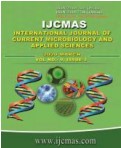


 National Academy of Agricultural Sciences (NAAS)
National Academy of Agricultural Sciences (NAAS)

|
PRINT ISSN : 2319-7692
Online ISSN : 2319-7706 Issues : 12 per year Publisher : Excellent Publishers Email : editorijcmas@gmail.com / submit@ijcmas.com Editor-in-chief: Dr.M.Prakash Index Copernicus ICV 2018: 95.39 NAAS RATING 2020: 5.38 |
A field experiment on Integrated Nutrient Management in sorghum-chickpea cropping system was conducted to identify an ideal integration of organic and inorganic nutrient sources for getting maximum yield and monetary benefit with minimum input cost. The experiment on sequence of kharif sorghum and rabi chickpea was conducted during kharif season of 2013-2015 at the farm of Sorghum Research Unit(CRS) Dr.PDKV,Akola The experiment was conducted in RBD with the nine nutrient management treatments in Kharif for sorghum which were T1-100% RDN through inorganic fertilizer,T2-50% RDN through inorganic fertilizer+50% RDN through FYM ,T3-75% RDN through inorganic fertilizer+25% RDN through FYM ,T4-50% RDN through inorganic fertilizer + 50% RDN through vermicompost ,N5:75% RDN through inorganic fertilizer + 25% RDN through vermicompost,T6-50% RDN through inorganic fertilizer+25% RDN through FYM+25% RDN through vermicompost,T7-75% RDN through inorganic fertilizer + 25% RDN through FYM+ seed treatment with microbial fertilizers PSB+ Azospirillum, T8-75% RDN through inorganic fertilizer+25% RDN through vermicompost+ seed treatment with microbial fertilizers PSB+ Azospirillum,T9-75% RDN through inorganic fertilizer + seed treatment with microbial fertilizers PSB+Azospirillum. Whereas chickpea was gown on the same randomization without application of fertilizers in rabi. The integration of organic and inorganic fertilizers were superior to inorganic treatments alone for both crops in sequence. Application of 75% RDN through inorganic fertilizer+ 25% RDN through FYM + seed treatment with PSB + Azospirillum to kharif sorghum and growing rabi chickpea without recommended dose of fertilizer recorded higher economic returns and B:C ratio of sole crop as well as system. This might be as a result of higher grain and fodder yield of sorghum as well as chickpea with the same treatment.
 |
 |
 |
 |
 |